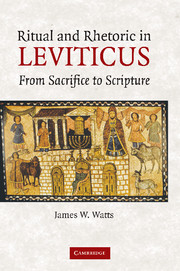Book contents
- Frontmatter
- Contents
- Abbreviations
- Preface
- Ritual and rhetoric in Leviticus
- 1 Introduction: Ritual Text and Ritual Interpretation
- 2 The Rhetoric of Ritual Instruction
- 3 The Rhetoric of Burnt Offerings
- 4 The Rhetoric of Sin, Guilt, and Ritual Offerings
- 5 The Rhetoric of Ritual Narrative
- 6 The Rhetoric of Atonement
- 7 The Rhetoric of Priesthood
- 8 The Rhetoric of Sacrifice
- 9 The Rhetoric of Scripture
- Bibliography
- Index of Biblical Citations
- Index of Other Ancient Literature
- Index of Authors
- Index of Subjects
7 - The Rhetoric of Priesthood
Published online by Cambridge University Press: 22 July 2009
- Frontmatter
- Contents
- Abbreviations
- Preface
- Ritual and rhetoric in Leviticus
- 1 Introduction: Ritual Text and Ritual Interpretation
- 2 The Rhetoric of Ritual Instruction
- 3 The Rhetoric of Burnt Offerings
- 4 The Rhetoric of Sin, Guilt, and Ritual Offerings
- 5 The Rhetoric of Ritual Narrative
- 6 The Rhetoric of Atonement
- 7 The Rhetoric of Priesthood
- 8 The Rhetoric of Sacrifice
- 9 The Rhetoric of Scripture
- Bibliography
- Index of Biblical Citations
- Index of Other Ancient Literature
- Index of Authors
- Index of Subjects
Summary
The previous five chapters of this book have all arrived at the same general conclusion. Leviticus 1–16 justifies control of Israel's priesthood by Aaron's descendants and their monopoly over most of its duties, privileges, and sources of income.
Various features of these chapters unite in service to this persuasive goal. The instructions of Leviticus 1–7 work to establish themselves as the ultimate guidelines for Israel's cultic practices. Their refrains and repetitions not only encourage the audience to bring YHWH offerings and gifts, but they also insist that such worship be done in strict accord with the stipulations of this text of priestly instructions. The priority of the ʿōlāh, “burnt offering,” in Leviticus as well as elsewhere in biblical rhetoric serves to disguise the priests' economic interests in the temple cult behind an ideal of selfless worship. Because no human receives any economic benefit from an ʿōlāh, attention to it at the beginning of the ritual instructions draws attention away from other more numerous and more lucrative offerings. Rhetorical analysis of Leviticus 4–5 discovered here a case for innovating, or at least a defense of recent innovations, in ritual practice: the addition of the ḥaṭṭā᾽t, “sin,” and ʾāšām, “guilt,” offerings to Israel's regular worship. The chapters' frequent puns on the offering names emphasize that when ultimate issues are at stake, hearers and readers need to bring these offerings to the priests, who receive portions of most of them for their own use.
- Type
- Chapter
- Information
- Ritual and Rhetoric in LeviticusFrom Sacrifice to Scripture, pp. 142 - 172Publisher: Cambridge University PressPrint publication year: 2007

